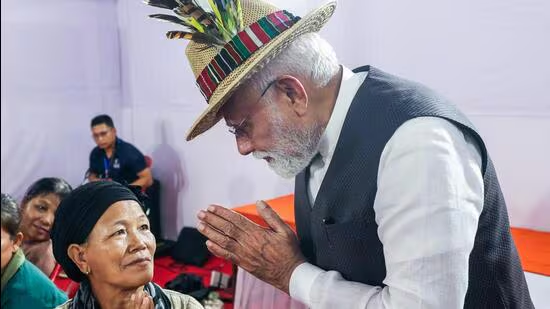A New Dawn for Manipur: PM Modi’s Message of Peace, Unity, and Development
- MGMMTeam

- Sep 13
- 3 min read
Prime Minister Narendra Modi’s long-awaited visit to Manipur on September 13, 2025, came as a significant moment for a state that has endured more than two years of violence and division. Since ethnic clashes erupted in May 2023 between the Meitei and Kuki-Zo communities, the northeastern state has witnessed over 260 deaths, the displacement of more than 60,000 people, and widespread destruction of homes and infrastructure. This was Modi’s first trip to Manipur since the crisis began, and it carried with it a clear message: the central government stands firmly with the people of Manipur in their journey toward peace and renewal.

Healing Divides in Imphal and Churachandpur
During his visit, the Prime Minister made a deliberate effort to address both sides of the conflict. In Imphal, the heart of the Meitei-dominated valley, and in Churachandpur, a tribal-dominated hill district, Modiji spoke about the need to bridge the divisions that have fractured the state. His words emphasized that violence erodes not only lives but also the identity and future of Manipur’s youth. By directly engaging with displaced families in relief camps and offering reassurances of government support, he sought to build confidence that a new chapter of healing and reconciliation is possible.
Development Projects as a Path to Renewal
Alongside his appeal for peace, Modiji inaugurated and laid the foundation for a wide range of development projects. In Imphal, projects worth nearly ₹1,200 crore were launched, including urban road and drainage works, new women’s hostels, and infotech initiatives aimed at creating opportunities for the younger generation. In Churachandpur, projects worth over ₹7,000 crore were announced, encompassing the upgrading of highways and other infrastructure critical to connectivity between the Valley and the Hills. These measures were reinforced by a special central aid package of ₹3,000 crore, of which ₹500 crore is dedicated specifically to the rehabilitation of displaced persons.
The Humanitarian Challenge
Despite these announcements, the humanitarian challenges in Manipur remain daunting. Thousands continue to live in overcrowded relief camps with inadequate access to healthcare, education, and sanitation. For many families, the prospect of returning home is still uncertain, as their villages remain destroyed or unsafe. Human rights organizations have repeatedly urged the government to prioritize rehabilitation and ensure accountability for the violence that scarred the state. The imposition of President’s Rule in early 2025 underlined the gravity of the situation, but also raised concerns about governance, representation, and the long-term trust of all communities.
The Political Dimension
Beyond immediate relief and development, Manipur’s crisis carries a strong political undercurrent. Tribal leaders, particularly Kuki-Zo MLAs, have urged the central government to consider either separate administrative arrangements or Union Territory status for tribal areas. These demands reflect deep-seated mistrust in the existing state administration and highlight the delicate balancing act required to preserve both peace and unity. Modiji’s visit, while a step toward rebuilding confidence, also places pressure on New Delhi to navigate these political aspirations without exacerbating existing tensions.
Rebuilding Trust Through Action
The visit’s symbolism cannot be overstated. For communities that felt abandoned, Modiji’s physical presence after two years offered reassurance. Yet words and promises must be translated into concrete outcomes. Safe rehabilitation of displaced families, transparent execution of development projects, and the establishment of justice mechanisms are essential to ensure that trust is not only restored but sustained. Without these steps, the risk of renewed conflict remains real.
The MGMM Outlook
Prime Minister Narendra Modi’s visit to Manipur marks a crucial moment for a state torn by ethnic clashes since 2023. His presence after more than two years of unrest sent a strong message that the Centre stands firmly with the people. By addressing both Meitei and Kuki-Zo communities in Imphal and Churachandpur, Modiji underlined the urgency of healing divisions and safeguarding the future of Manipur’s youth. His direct interaction with displaced families, along with reassurances of government support, highlighted the intent to restore confidence and unity in a region struggling with displacement, insecurity, and mistrust.
At the same time, the launch of massive development initiatives worth nearly ₹8,200 crore, along with a special central aid package of ₹3,000 crore, placed growth and rehabilitation at the heart of renewal. Projects spanning urban infrastructure, women’s hostels, IT initiatives, and improved connectivity between the Valley and the Hills were showcased as the government’s roadmap to rebuild lives and livelihoods. Yet, the challenges remain daunting, with thousands still confined to relief camps and calls for justice and fair rehabilitation growing louder. Modi’s visit, therefore, is more than symbolic—it is a call to rebuild trust, deliver on promises, and ensure that peace, unity, and development truly reach the people of Manipur.
(Sources: Hindustan Times, Times of India, Economic Times)




Comments